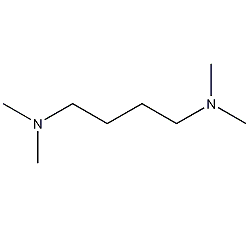N,N,N’,N’-Tetramethyl-1,4-diaminobutane N,N,N’,N’-Tetramethyl-1,4-diaminobutane


Structural formula
| Business number | 033R |
|---|---|
| Molecular formula | C8H20N2 |
| Molecular weight | 144.26 |
| label |
Tetramethylbutanediamine, 1,4-Bis(dimethylamino)butane, 2,7-Dimethyl-2,7-diazaoctane, Tetramethyldiaminobutane, Universal reagents |
Numbering system
CAS number:111-51-3
MDL number:MFCD00008338
EINECS number:203-878-5
RTECS number:EJ7530000
BRN number:1735538
PubChem number:24847761
Physical property data
1. Characteristics: Undetermined
2. Density (g/mL,20℃): 0.792
3. Relative vapor density (g/mL,Air=1): Undetermined
4. Melting point (ºC): Undetermined
5. Boiling point (ºC,Normal pressure):166-167
6. Boiling point (ºC,0.266kPa): Not determined
7. Refractive index: 1.428
8. Flashpoint (ºC): Undetermined
9. Specific rotation (º): Undetermined
10. Autoignition point or ignition temperature (ºC): Undetermined
11. Vapor pressure (mmHg,20ºC): Undetermined
12. Saturated vapor pressure (kPa,20 ºC): Undetermined
13. Heat of combustion (KJ/mol): Undetermined
14. Critical temperature (ºC): Undetermined
15. Critical pressure (KPa): Undetermined
16. Oil and water (octanol/Log value of the partition coefficient for water: undetermined
17. Explosion upper limit (%,V/V): Undetermined
18. Lower explosion limit (%,V/V): Undetermined
19. Solubility:Undetermined
Toxicological data
None
Ecological data
None
Molecular structure data
5. Molecular property data:
1. Molar refractive index: 46.55
2. Molar volume (m3/mol):175.0
3. isotonic specific volume (90.2K):401.8
4. Surface Tension (dyne/cm):27.7
5. Polarizability(10-24cm3):18.45
Compute chemical data
1. Reference value for hydrophobic parameter calculation (XlogP): 1
2. Number of hydrogen bond donors: 0
3. Number of hydrogen bond acceptors: 2
4. Number of rotatable chemical bonds: 5
5. Number of tautomers: none
6. Topological molecule polar surface area 6.5
7. Number of heavy atoms: 10
8. Surface charge: 0
9. Complexity: 59.7
10. Number of isotope atoms: 0
11. Determine the number of atomic stereocenters: 0
12. Uncertain number of atomic stereocenters: 0
13. Determine the number of chemical bond stereocenters: 0
14. Number of uncertain chemical bond stereocenters: 0
15. Number of covalent bond units: 1
Properties and stability
None
Storage method
None
Synthesis method
None
Purpose
None
.75pt; TEXT-INDENT: -54.75pt; TEXT-ALIGN: left; mso-margin-top-alt: auto; mso-margin-bottom-alt: auto; mso-list: l0 level2 lfo1; tab-stops: list 36.0pt” align=left>4. Surface Tension (dyne/cm): 27.7
5. Polarizability(10-24cm3):18.45
Compute chemical data
1. Reference value for hydrophobic parameter calculation (XlogP): 1
2. Number of hydrogen bond donors: 0
3. Number of hydrogen bond acceptors: 2
4. Number of rotatable chemical bonds: 5
5. Number of tautomers: none
6. Topological molecule polar surface area 6.5
7. Number of heavy atoms: 10
8. Surface charge: 0
9. Complexity: 59.7
10. Number of isotope atoms: 0
11. Determine the number of atomic stereocenters: 0
12. Uncertain number of atomic stereocenters: 0
13. Determine the number of chemical bond stereocenters: 0
14. Number of uncertain chemical bond stereocenters: 0
15. Number of covalent bond units: 1
Properties and stability
None
Storage method
None
Synthesis method
None
Purpose
None
